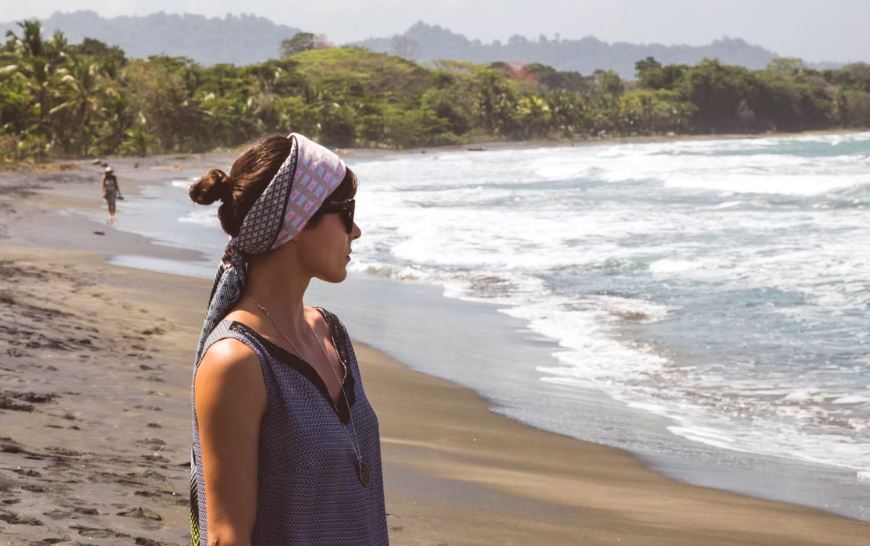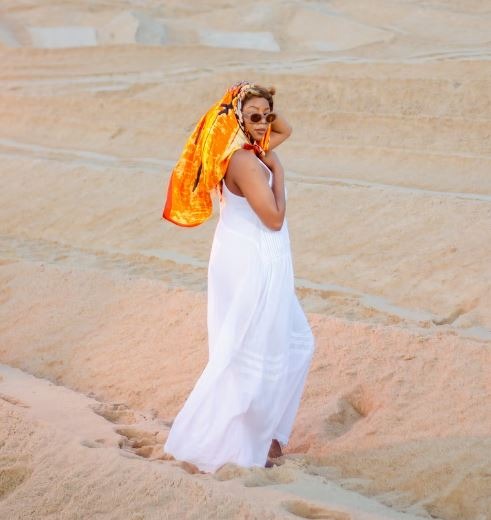On some days, your hair feels stunning, pristine, and lovely enough to serve as the face of a hair-care advertisement. Occasionally, not so much. You simply can’t be bothered to deal with it because it’s dirty, frizzy, or appears to have grown a new cowlick. A headscarf can be useful whether you’re trying to cover up bad hair days, want to shield your hair from wind or rain, or are simply bored and want to try a new look. In addition, the Headscarf is one of the best beach cover-ups and wraps.
Although it isn’t particularly trendy, wearing a headscarf is a fun way to switch up how you wear the winter accessory. The advantage of this particular hair accessory is how adaptable it is: You can create a ton of different looks with just one scarf, from extremely simple to elaborately detailed.
Wearing Head Scarf To The Beach
An infinity scarf is what you require. Infinity scarves, which are unique from regular scarves in that they have no ends and instead connect to form a full circle, should be noted.
How To Use Head Scarf To The Beach
- With the excess fabric hanging behind your shoulders, wear the scarf around your head like a hood.
- Bring the scarf’s bottom to one side and place it low on your neck.
- Twist the bottom of the scarf tightly, leaving a tiny loop at the very end. The scarf will coil upward as a result of the twist.
- Make a bun at the side of your head by wrapping the scarf around the coil.
- To secure the bun, circle the end loop around it. With this hair-protecting, retro-inspired look, you are ready to hit the beach this summer.
How To Choose A Headscarf?
Naturally, the type of headscarf you select will depend on your needs, but there are several important considerations when choosing one for your head scarf ideas for the beach and pool:
1. Shape
You can select a headscarf in one of two shapes: square or rectangular. The most versatile hairstyles can be created using square headscarves, but make sure the scarf you choose is large enough for the look you want. It should be at least 28 by 28 inches in size if you want it to completely or mostly cover your head. Although they don’t have quite as many uses as their perfectly square cousins, rectangular head scarves, also known as oblong or long scarves, do have other advantages. If you prefer the look of excess fabric hanging down or if you want to make a full headwrap or turban, you should probably use a rectangular style.
2. Fabric
Depending on the look you’re going for, you also want a scarf that will stay on your head while being fashionable and machine-washable. Some of the best fabrics are made of lightweight wool or cotton because they maintain their shape. While silk and satin fabrics are beautiful, they tend to slip off, which can be a little annoying. Nonetheless, they are excellent for protecting your hair.
How To Prevent Damage From Wearing A Head Scarf
The main benefit of silk and satin scarves is that they don’t damage your hair all that much, even though it can be difficult to get them to sit nicely and securely on your head. Contrarily, scarves made of non-silk tend to rob your hair of moisture, leaving it dry and brittle. Before accessorizing with a headscarf, you can simply braid your hair if you don’t want to sacrifice your appearance. Try to wear head coverings only occasionally. Every once in a while, a cute cotton scarf on your way to brunch won’t do much harm.
Ways To Wear Head Scarf
1. The Pony Tie
Simply tying a scarf around a ponytail is one of the simplest ways to include one in your ensemble. If you can tie a knot, this works with pretty much any size or shape. If you want to give your scarf some extra staying power and prevent the silk fabric from falling down your ponytail, loop it through a hair elastic before tying it.
2. The Twisted Headband
To roll or fold a square scarf, start at the widest side and move toward the pointed corners after first folding it in half diagonally. Simply begin folding along the long side of a rectangular scarf if you’re using one. At the nape of your neck, tuck the loose ends under your hair. After rolling the scarf, you can also tie a knot in the middle to keep it folded and add a little more volume at the top.
3. The Bandana
Lizzie McGuire called and is delighted to once more share with you one of her distinctive looks. This is your simplest option if you’re really not feeling your hair or simply want to hide a third-day blowout that probably should have retired after being a two-day blowout. Just tie the two opposite ends of a square scarf under your hair and leave the third corner untied after folding it in half diagonally.
4. The Bandana Cap
Very similar to the above, but instead of having a summer camp or early 2000s vibe, the bandanna cap has a much more ’70s vibe and only needs one minor execution change. Tie your scarf over your hair’s top strands and over the frayed corner instead of knotting it below your hair. Then, to finish off, tuck the extra fabric under the knot.
5. The Babushka
The babushka is a hairstyle that is popular among Eastern European grandmothers and fashion-conscious rappers alike. It is incredibly simple to do and stays in place even if you spend the entire day moving around. Start by diagonally dividing a square scarf in half. Then, tie a knot under your chin with the two opposite ends.
6. The Grace Kelly
Old Hollywood starlets favored this look, also known as the Babushka 2.0, especially when they were cruising through the South of France in stylish convertibles. So yes, it’s a great option for dealing with wind, rain, or humidity. It only requires one extra step and a slightly larger scarf than the babushka. Wrap the ends of your scarf around your neck and over the back corner before tying them into a knot, as opposed to simply tying them under your chin.


